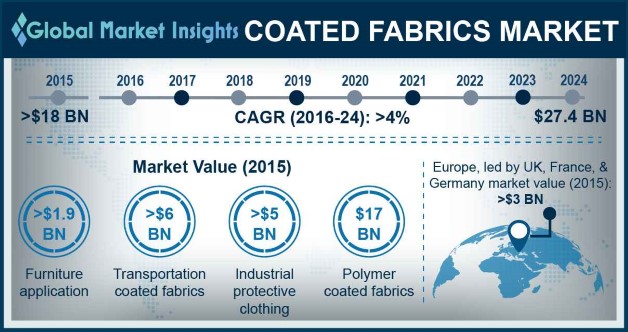Get a free sample of Coated Fabrics Market
Thank you!
Your inquiry has been received. Our team will reach out to you with the required details via email. To ensure that you don't miss their response, kindly remember to check your spam folder as well!
Form submitted successfully!
Error submitting form. Please try again.
Get a free sample of Coated Fabrics Market
Thank you!
Your inquiry has been received. Our team will reach out to you with the required details via email. To ensure that you don't miss their response, kindly remember to check your spam folder as well!
Form submitted successfully!
Error submitting form. Please try again.
Coated Fabrics Market Size
Global Coated Fabrics Market size surpassed $18 billion in 2015, with estimated gains at over 4% CAGR from 2016 to 2024. Strong application outlook in manufacturing air bags and seat covers in automotive industry coupled with stringent regulatory compliances to give protective clothing to labors are key trending factors driving global market.
Global automobile sales were over 86 million units in 2015. Passenger cars contributed about 63 million units and commercial sales were 20 million units in the same year. Automobile production is projected to surpass 100 million units by 2018. Increasing automotive sales in China, Thailand, India, and Indonesia should stimulate the coated fabrics market share. Consistent aesthetic improvements & scope for seat cover design customization will promote product use as a low-cost alternative to leather.

Global industrial protective clothing spending was over USD 5 billion in 2015, increasing at over 14% CAGR. Agriculture, chemical processing, food processing, law enforcement, medical, and military are major industries using protective clothing where participants must be shielded from chemicals, heat, biological contaminants, or other environmental risks.
Government implementations such as Model Work Health and Safety Act in Australia and European Union’s Directive 89/686/EEC are influencing industries towards industrial protective clothing adoption. Nylon is the most widely used coated fabric substrate over its counterparts such as polyester due to its light weight and amenability to a variety of coatings.
Industry profitability is mainly dependent on the production of end use products such as and competition level from alternative materials including plastic, leather, and uncoated fabrics, and rubber sheeting. Transportation sector majorly influenced the coated fabrics market revenue due to product applicability in motor vehicles, aerospace, and marines.
Presence of many substitute materials including leather & plastics accompanied by toxic residue while manufacturing may threaten industry growth. Comparatively less cost of plastic and having large applicability could impact on the coated fabrics market trend.
How are protective clothing applications bolstering the coated fabrics market forecast?
The coated fabrics industry size from protective clothing applications is anticipated to strike a 4% CAGR through 2024 driven by the rise in the number of standardized safety protective measures.
What is the Europe coated fabrics market worth?
The coated fabrics industry size in Europe will see inclination with the booming transportation and protective clothing sector across the region.
How big is the rubber coated fabrics market?
Demand for rubber coated fabrics is expected to reach more than USD 2 billion through 2024 owing to the higher need for enhanced durability, flexibility, elasticity, and resistance to degradation properties.
What is the size of the coated fabrics industry?
The market share of coated fabrics is slated to witness gains at around 4% CAGR up to 2024 owing to increasing adoption in manufacturing airbags and seat covers across the automotive sector.